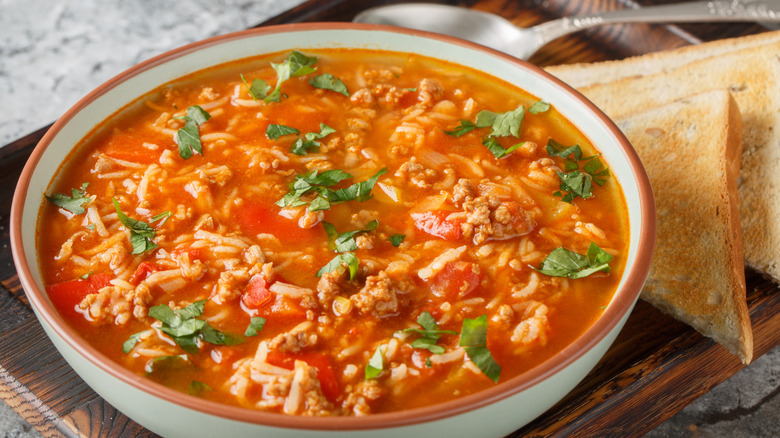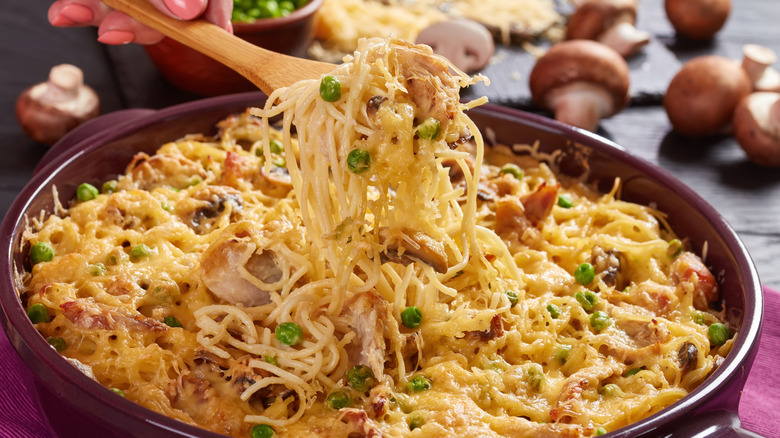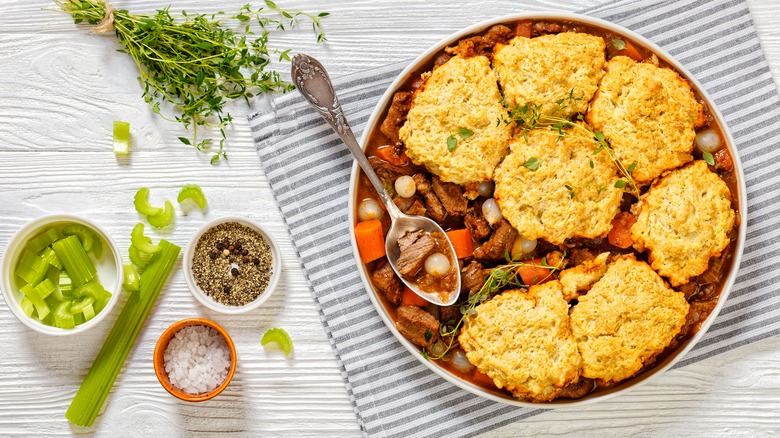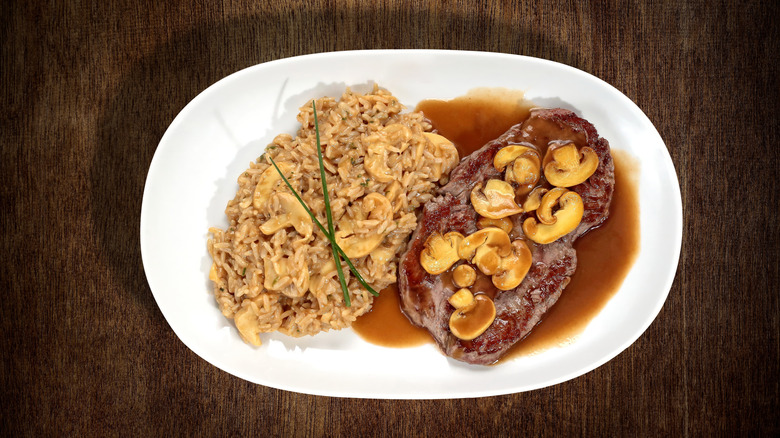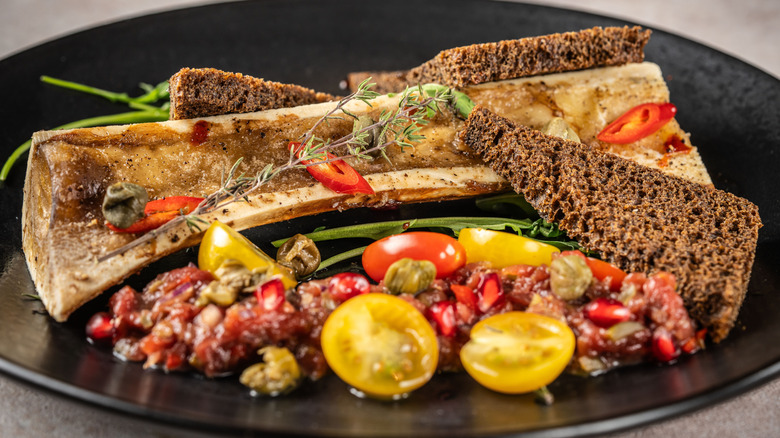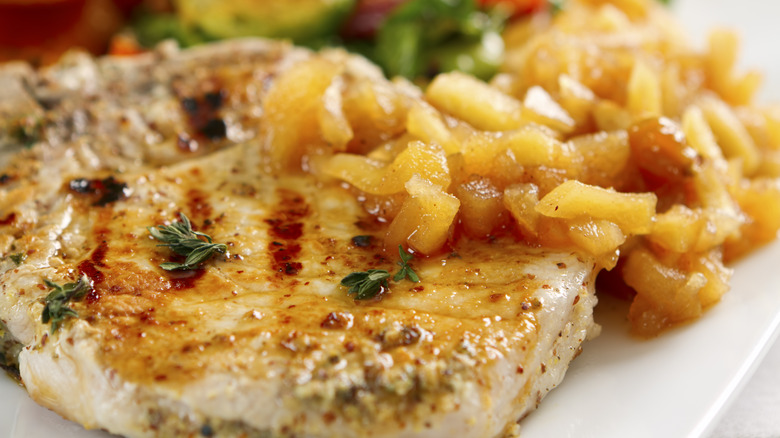Old-School Winter Dishes People Rarely Make Anymore
When cold weather starts blowing in each year, all home cooks eagerly retreat to their kitchens to whip up plenty of stews, casseroles, and other comfort dishes. Chili, macaroni and cheese, and beef stew may be the stars of winter menus nowadays, but things used to be quite different, even just a couple of generations back. Due to evolving tastes, and access to resources, there are lots of cold-weather dishes that many modern Americans wouldn't even recognize.
What kinds of dishes did Americans make to warm up, and keep their bellies full in the past? Some home chefs are having a blast finding out, dusting off old recipes passed down from generations, and rediscovering international influences that were close to being forgotten. It's fun to keep history alive in the kitchen. Read on to dig into some fascinating, old-school winter dishes that used to be common, but are hard to find nowadays. You may end up excited to try some of them yourself this season.
Turkey Tetrazzini
Baked ziti and lasagna are the darlings of baked pastas today, but turkey Tetrazzini used to steal the show. For those unfamiliar, this comfort food classic includes turkey, spaghetti, mushrooms, and a luscious sauce made with cream cheese, heavy cream, mozzarella, and Parmesan.
Turkey Tetrazzini was on the menu more often several decades ago because it was the perfect way to use up leftover turkey. Back when a single income could support an entire household, the adult not working outside the home could make more extravagant, time-consuming meals. Things like turkey roasts were a weekly affair, not saved for special holiday meals. And if the family couldn't eat the whole bird, turkey Tetrazzini followed shortly after. This was certainly more glamorous than simply reheating the leftovers, and the thick sauce worked wonders to keep the turkey moist.
There are still some families who know, and love turkey Tetrazzini, but sadly, they only make it after Thanksgiving. If you're interested in eating this dish on a more regular basis, you can cut down on the prep time by buying, and using a rotisserie chicken instead.
Oxtail stew
Most people buy chuck or round when they're craving beef stew. But the succulent dish's predecessor, oxtail stew, uses a cheaper cut of beef. Oxtail stew was once a clever, common way to make affordable meals, and also use up more parts of the cow.
As the name implies, oxtail comes from the tail, an area with lots of collagen, and meat that's quite tough. Slowly cooking it in a stew will make it more palatable, but it definitely isn't a beginner-friendly cut. While cheaper, oxtail also has a higher fat content, which means that people have to either trim their beef carefully, or periodically skim the fat off the top of their stew.
These reasons explain why Americans choose the simplicity of other cuts of beef today. It's also worth noting that oxtail has had some good publicity in the culinary world, which has driven up the demand. Prices are much higher now compared to in the past, in part because of our changing perceptions. You can still make a beautiful oxtail stew, but you may have to spend more money, as well as more time in the kitchen.
Potato lasagna
There are plenty of interesting ways to make lasagna, but they're not equally common. Many people have seen trendy lasagna rolls on their social media feeds, but not as many have heard of potato lasagna, made with slices of potato instead of pasta sheets.
Lasagne di patate, as the Italians call it, was invented around World War II. During times of hardship, people have come up with brilliant ways to feed their families, using any ingredients available to them. When flour was harder to come by, potatoes filled in for pasta as a nutritious, and reliable source of beneficial carbohydrates. Similarly, vegetables were often substituted for more expensive meat in the tomato sauce. But once conditions improved after the war, people had the luxury of adding more delicious ingredients to their potato lasagna, such as ground beef. Italian-American families frequently prepared variations of this dish in the 1950s. Nowadays, while people still love a classic lasagna made with pasta, our increased demand for delicious gluten-free recipes could lead to potato lasagna seeing another resurgence.
Mock turtle soup
Turtle soup was a staple for centuries, starting from when international sailing became popular. Turtles can grow quite large, which means that turtle soup could feed an entire ship. As sailors spread the news about delicious turtle soup, more people wanted to try it. Royalty scrambled to get their hands on the exotic meat, and sailors had to transport live turtles they'd captured, which was a difficult ordeal. Turtle soup became so popular that many species ended up on the endangered list. Once turtles were hunted nearly to extinction, folks who'd developed a taste for it had to satisfy their cravings elsewhere. Thus, mock turtle meat was invented.
Campbell's and Heinz sold versions of canned mock turtle, so anyone could enjoy the soup without harming endangered turtles. But these brands had to get the meat from somewhere, and those with weak stomachs did not like to learn that canned mock turtle soup was made with calves' heads. While some noteworthy people, like Andy Warhol, were huge fans of mock turtle soup, the production process proved too unsavory for most. Heinz and Campbell's eventually stopped producing it and, by the middle of the 20th century, mock turtle soup had faded into obscurity.
Shepherd's pie with lamb
There's no denying that shepherd's pie is still on many Americans' regular meal rotation during the colder months. However, the version that we create now varies slightly from the original recipe that came from the UK. Since the UK has tons of gorgeous green hills, lots of folks there have raised sheep for countless generations. As a result, lamb was often on the dinner table.
The first shepherd's pie is believed to have come from Scotland. The Scottish version used pastry dough rather than mashed potatoes. We can thank the Irish for putting their own spin on it, and giving us the mashed potato topping we know now.
Once Americans got their hands on the dish, they in turn added their own spin, and used ground beef out of sheer convenience. If you want to get technical, we shouldn't even refer to the version made with ground beef as shepherd's pie, since it's traditionally supposed to contain lamb or mutton. One with ground beef, rather, should be called cottage pie. While no one bats an eye at this common mix-up, it's fascinating to learn about the iconic dish's origins, and how it's evolved over time.
Carrot casserole
If you have a hankering for a unique recipe that predates the 21st century but uses recognizable ingredients, you may want to set your sights on carrot casserole. The humble dish is made with canned sliced carrots, Velveeta cheese, Ritz crackers, and a stick of margarine or butter, all baked together to create a decadent, gooey casserole.
Believe it or not, Velveeta, the strange cheese we love to hate, and hate to love, was invented all the way back in 1918. Ritz crackers followed shortly after in the 1930s. Canned vegetables were also available during this time.
At first glance, it's incredible that these popular ingredients are in our kitchens today, but carrot casserole couldn't withstand the test of time. Upon further scrutiny, though, it's easy to guess why carrot casserole suffered this fate. There isn't much nutritional value, for one thing. Carrots are great for us, but they can't do so much heavy lifting that people will forget about the artery-clogging butter, and melted cheese. Of course, this doesn't explain why broccoli prevails as the mightier vegetable, even when drowned in the same dairy-based ingredients. Perhaps its green color serves to make people feel a little less guilty about indulging.
Winter vegetable cobbler
When one thinks of a cobbler, they typically imagine ripe peaches, blueberries, strawberries, and other fruits getting a sweet pastry makeover. Less often, they think of a shoe repairmen. One thing they hardly ever think about is a savory cobbler, even though Americans adored them in the past. Whether they were harvesting their crops or trying to think of a quick, convenient use for canned or frozen veggies, winter vegetable cobblers were once top of mind. They acted as a celebration of the hearty, nutritious veggies available during the colder months, like onions, potatoes, carrots, broccoli, cauliflower, and winter squash.
If getting enough veggies into your diet is a bit daunting, consider adding them to a thick, creamy sauce, then baking some biscuits on top. It's a sure-fire way to make them gourmet, and there are lots of traditional, and modern takes to choose from. Some old-fashioned recipes call for an approach similar to making soup, but it's important not to use too much vegetable broth. If this dish sounds right up your alley, it's up to you to decide whether or not to use vegetable broth as your base, or make a roux. You can also make other adjustments to suit your tastes, and use what you have on hand. Fresh, in-season vegetables are always fabulous, but any mix will hit the spot. There's no clear reason why savory cobblers aren't more widespread today. Maybe we just love chicken and dumplings more.
Steak Diane
One of the reasons why fajitas taste better at restaurants is that they always come served on an impressive, sizzling platter. It's clear that people appreciate some dramatic flair when they're dining. With this in mind, it's easy to see why a dish like steak Diane once stole our hearts.
On the surface, steak Diane is simply beef tenderloin topped with a buttery, creamy sauce. As restaurants started to add it to the menu, they beefed things up by adding some mushrooms on top. But what really gives steak Diane its wow factor is the addition of a splash of cognac, which is set on fire at the table to let the alcohol burn off.
Steak Diane hit the peak of its fame in the '50s, and '60s. Ordering the dish gave people the chance to feel super fancy, and enjoy the theatrics created just for them. But as businesses across all industries became more concerned with liability, and efficiency, steak Diane was abandoned for obvious reasons: Flambéing is not particularly safe, and it takes up precious time. Americans have such packed schedules, and they don't appreciate waiting for a table, so it makes sense that restaurants ditched the dish. You can still make steak Diane at home, though, as long as you know how to safely flambé.
Roasted bone marrow on toast
Cooking with bones can admittedly be a little unsettling, but savvy home cooks know that throwing some into soup can make the broth more nutritious, and more delicious. Everything gets mixed into the soup as it cooks, and then the bones get discarded before serving. But when you're ready to make bones the star of a dish, you'll be rewarded with next-level results.
Back when using all parts of the animal was viewed as more important, Americans used all kinds of cuts that aren't common nowadays. This is how roasted bone marrow dishes became widely accepted stateside. But humans have been eating bone marrow for centuries, and slathering it on toast is very British, especially since the 1990s, when Fergus Henderson started serving it at his London restaurant, St. John. Henderson's rendition became an instant hit, and sailed across the Atlantic to American restaurants.
Decades later, you may still be able to find this dish in some upscale establishments, but its popularity has definitely taken a hit. We may have hope for a resurgence, though, and someday return roasted bone marrow on toast to the average diner. With celebrity chefs like Andrew Zimmern praising roasted bone marrow, it could become the next avocado toast.
Ham and beans
Have you ever roasted a ham for Thanksgiving or Christmas, only to end up with a lot of leftovers? Dicing it up, and throwing it into a salad or omelet is always a reliable option, but it's worth broadening your horizons, and whipping up a hearty dish of ham and beans. It's a dish that dates back to the Great Depression, when cheap and nutritious beans were a crucial ingredient. Packed with protein and fiber, they allowed people to cook filling meals for less money. To make things taste more luxurious, some would add the leftover ham bone with a little bit of meat still left on it to the beans. The best part is that no food went to waste.
To make old-fashioned ham and beans, combine Great Northern beans with a little bit of diced ham, a ham bone with a little meat on it, brown sugar, diced onion, garlic salt, and pepper. It may not seem like much, but once this mixture has the chance to simmer for a few hours, magic happens. The liquid thickens, and the sweet and savory flavors marry. It's a stew that's filling enough to enjoy as a meal, especially when served with cornbread, but it can also work as a side dish in smaller portions.
Perhaps the reason why ham and beans is not popular today is that it symbolizes struggling. But this tasty meal deserves everyone's consideration as they get ready to hunker down this winter.
Hoosier chili
While everyone's busy debating whether or not to add beans to chili, we're thinking about a different addition altogether: spaghetti, a key ingredient in Hoosier chili, an old-school winter dish that people hardly make anymore. It contains the usual ingredients that make chili delicious, such as ground beef, beans, onions, bell peppers, tomatoes, and spices — and also spaghetti, right there in the mix.
While no one is entirely sure where Hoosier chili came from, some vintage recipes date back to the early 1900s, and it's clear that Hoosier chili belongs to Indiana. It's easily mocked because it strays from what we've come to expect from a standard chili, but the people who've tried it say that it's delicious. And if you're wondering about the logistics of eating it without making a mess: You're supposed to break the spaghetti in half before you dump it directly into the simmering chili pot. That makes it a bit easier to slurp up, but you can still expect to get a little saucy once you dig in.
While Hoosier chili isn't popular these days outside of the Midwest, we shouldn't judge it too harshly. After all, some people like cornbread with chili, while others prefer to eat it over rice. Carbs are beautiful in all forms, so it's worth giving Hoosier chili a shot.
Mincemeat pie
If you think mincemeat pie sounds super old-fashioned, you're right. Some written recipes date back to the 1700s, but this dish is likely even older than that. And despite its rich history, it's among the many pie flavors you don't see many people eating today.
Mincemeat pie gets its name from the various cheap cuts of meat that are blended together to make a convenient pie filling. Some people used to make it with cow tongue, but these days, modern recipes typically call for ground beef.
If you're not a fan of combining sweet and savory flavors, you wouldn't like mincemeat pies. The meat is cooked with apple cider, chopped apples, raisins, and warm spices like cinnamon, and nutmeg. Since most people expect something fruity or chocolatey when they look at a pie, biting into a mincemeat pie can feel like a trick if your taste buds aren't expecting meat. While Europeans still love this historical dish, especially during the holiday season, it just couldn't get its footing in modern American culture.
Pork chops and applesauce
Pork chops and applesauce was once such an American dish that it was mentioned on shows like "The Brady Bunch," and "The Simpsons." One reason why it was so popular was that farmers would slaughter their pigs, and harvest their apples at the same time each year, as the weather began to cool down. For many folks, pork chops and applesauce was a comfort food that signified, and brightened, the colder months.
There are many theories as to why we've since moved away from this once iconic pairing. It's possible that the modern American diner simply tired of eating the same things, and began to crave more innovative foods. Another possibility is that, as we've continued to experiment with cooking lean cuts of meat like pork chops, we've learned how to better keep them juicy. There are so many incredible pork chop recipes that don't rely on applesauce to be palatable, and moist. So, while the dish is still beloved by some, its vintage reputation has turned many folks toward newer, more exciting possibilities.
Porcupine meatballs
With a name like porcupine meatballs, this dish might have you scared to pop one into your mouth, and bite down. But rest assured, porcupine meatballs don't have quills. Instead, they are like regular meatballs, save for the addition of white rice.
This dish is another Great Depression-era gem that allowed Americans to continue to enjoy their classic comfort foods, while also stretching expensive ingredients like meat. The dish is called porcupine meatballs because the rice grains poke out, making them look spiky instead of perfectly round.
One thing worth noting is that there are no breadcrumbs in this recipe. The rice acts as the binding agent, and since the grains soak up liquid, they also keep the meat juicy. All you need to do is mix the ingredients together, form balls, sear them until each side has browned, and then add a mixture of chicken stock, and tomato sauce. The meatballs need to simmer for around 45 minutes to ensure that the rice is fully cooked.
